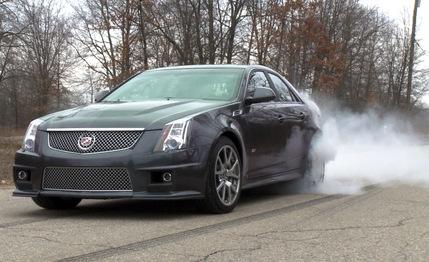 Short Take Road Test
Short Take Road Test
It’s widely known that the denizens of this shop prefer manual transmissions to automatics. Even though the advent of dual-clutch automated manuals has begun to erode this tribal preference, it’s still hard to beat the sense of car-and-driver involvement that goes with a crisp-shifting manual gearbox.

The Tremec TR6060 six-speed manual offered on the Cadillac CTS- V is an excellent case in point—precise engagements, reasonably short throws, a sweet clutch, and gear ratios well matched to the supercharged and intercooled 6.2-liter V-8. Actually, it isn’t difficult to match transmission gearing to an engine that generates 556 hp and 551 lb-ft of torque, but never mind. Given the seductive credentials of the Tremec manual, we make no apologies for taking so long to test the CTS- V automatic. On the other hand, having experienced the self-shifting six-speed auto—a no-cost option that wasn’t offered with the first-generation CTS- V—we do regret having waited.
Full Speed Ahead
You already know that for all its substantial mass—this test car weighed in at a hefty 4268 pounds—the performance king of all Caddys is capable of serious haste. In our first road test, we pedaled a manual CTS- V to 60 mph in 4.3 seconds, to 100 in 9.7, through the quarter-mile in 12.6 at 116 mph, and on to a top speed of 191 mph. Heady numbers. But the automatic CTS- V trumps almost all of them: 0 to 60 in 3.9, 100 in 8.7, and the quarter in 12.2 at 119. Top speed with the automatic, achieved in fifth gear, is redline-limited to 178 mph, but it’s hard to think of many situations where this could prove frustrating.
The Caddy’s zero-to numbers compare favorably with those of the slightly smaller but similarly priced BMW M3 and Mercedes-Benz C63 AMG. For further perspective, a BMW M5, which is basically the same size as the V , hit those same marks in 4.2, 9.4, and 12.5 at 118 mph, respectively. And with a base price a little more than $60,000, the CTS- V starts nearly 30 grand below the M5—and Mercedes’ E63 AMG, too. Call us crazy, but we think it’s hard to ignore a dollar disparity of that magnitude, good times or bad, especially when the Caddy’s back-road footwork is just as fancy as that of its Euro rivals, with the bonus of respectable ride quality.
Auto Pros and Cons
The six-speed automatic employed in the CTS- V is GM’s 6L90, a heavier-duty version of the 6L80 that was introduced in the 2006 Cadillac STS- V . As the CTS- V produces 87 more hp and 112 more lb-ft of torque than the STS- V , a more robust unit was in order.
To satisfy sporty types, Cadillac installed shift switches (as distinct from paddles) on the CTS- V ’s steering-wheel spokes, but we’re sorry to report that these aren’t as satisfying to use as some others. The transmission will hold gear selections up to the 6200-rpm redline and, unlike a good many so-called manumatics, won’t upshift on its own. But the collision with the rev-limiting fuel cutoff is abrupt, and timing your upshift too close to the redline results in a slow gearchange. That’s not good, because the redline is only 100 rpm above the engine’s horsepower peak.
In the end, we got our best acceleration rush by simply clicking the shift lever into D and standing on the gas. This has to be done judiciously, or your run will go up in smoke—there’s no launch control here. But even with all that brute force on tap, the throttle response is sensitive enough to manage power delivery without too much unseemly wheelspin, and its automatic up- and downshifts are smooth and prompt.
The Bottom Line
Having logged seat time in manual and automatic versions of the CTS- V , we’re inclined to believe the automatic may be the better choice, particularly for the slightly older guys who are most likely to step up to a car in this price range. The manual transmission might be the better choice on a racetrack, but how often is a sedan like this going to show up at track days? And as far as that goes, keep in mind that John Heinricy, GM’s erstwhile performance guru and nine-time SCCA national racing champion, set what GM says is a Nürburgring Nordschleife production-sedan lap record driving a CTS- V automatic.
The end result here is a supersedan that’s also outstanding as an everyday driver, particularly for those inclined to haste. By the standards of this class, its base price is a steal. And even with options adorning our test car—Recaro bucket seats ($3400, heartily recommended), navigation ($2145), Thunder Gray Chromaflair premium paint ($995), and a suede-clad steering wheel and shift knob ($300)—it’s a bargain.
But hurry. Whether you opt for the manual or automatic, the CTS- V isn’t likely to persist. Not with a $2600 gas-guzzler tax. Not with the Obama administration looking over GM’s corporate shoulder. Not with GM’s performance group disbanded and reassigned elsewhere in the corporation. Even allowing for the context of times past—the 1957 Eldorado Biarritz convertible, for example, was a standout ride in its day—the CTS-V is by far the most exciting Cadillac ever built. Get one while it lasts.